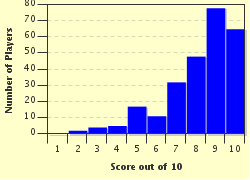Quiz Answer Key and Fun Facts
1. World War 2 had two of the largest land battles in history. What were they?
2. What term meaning "lightning war" was Germany's signature strategy for defeating their enemies?
3. What ironic sounding codename was given to the nuclear bomb that was dropped on Hiroshima?
4. Sharing the name of a famous doll, what Gestapo member was also known as the "The Butcher of Lyon"?
5. Nicknamed the "Mighty Mo", on what U.S. battleship did the Japanese surrender, officially ending World War 2?
6. What Soviet city was the location of a siege that lasted almost two and a half years?
7. Who was the only American soldier to be executed for desertion since the Civil War?
8. Located on the North African coast, where was the Allied Powers' first major land victory against the Axis powers?
9. In what battle was Germany's final western offensive and the most costly for the Americans?
10. What "Father of Rocket Science" played a key role in the development of German rockets?
Source: Author
skydude13579
This quiz was reviewed by FunTrivia editor
bloomsby before going online.
Any errors found in FunTrivia content are routinely corrected through our feedback system.

